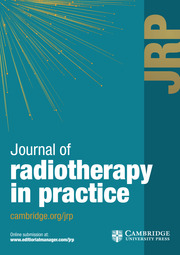No CrossRef data available.
Article contents
Dosimetric comparison of three-dimensional (3D), intensity-modulated radiotherapy (IMRT) and hybrid IMRT for left-sided postmastectomy radiation therapy (PMRT)
Published online by Cambridge University Press: 29 June 2023
Abstract
This study aimed to determine the suitable breast treatment technique for a small facility’s hospital with limited staff and equipment resources. The benefits and drawbacks of each technique should be considered to guide radiation oncologists choose the appropriate treatment option for postmastectomy radiation therapy (PMRT) patients.
This study included the computed tomography images of 15 patients who received left-sided PMRT. The patient’s characteristics were classified into two groups: 1. irradiation of only the chest wall (CW) and 2. CW lymph nodes plus supraclavicular lymph nodes (SPCs). All 15 PMRT patients were generated in 4 treatment techniques including 3DCRT, field-in-field (FiF), intensity-modulated radiotherapy (IMRT) and hybrid (3DCRT + IMRT). Each treatment technique’s dosimetric parameters and treatment time were compared.
All four treatment plans met the acceptable criteria. The IMRT plans achieved the highest plan quality scores for two groups of PMRT patients but require the longest treatment time, whereas the 3DCRT and FiF plans demonstrated superiority for organ at risk (OAR) sparing and required the shortest treatment time when compared with the IMRT and hybrid plans.
The IMRT plan had the highest plan quality but required the most time to treat. Treatment times are critical in facilities with limited resources. As a result, the FiF plan was found to be a suitable technique for both CW-only and CW plus SPC irradiation due to its short treatment time and high plan quality scores for OAR dose sparing.
- Type
- Original Article
- Information
- Copyright
- © The Author(s), 2023. Published by Cambridge University Press



